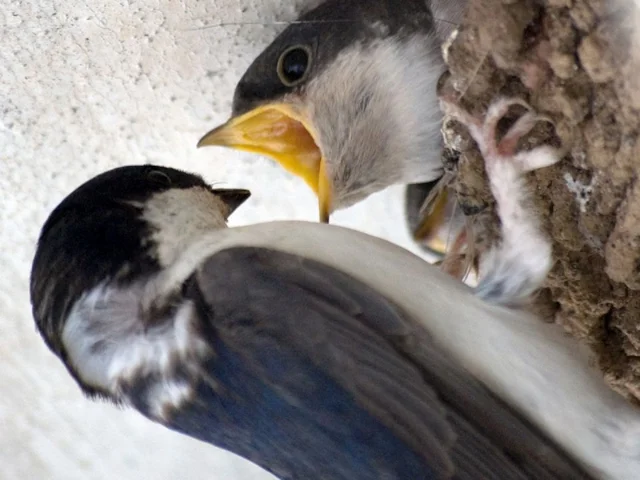House Martin mystery continues
0c87cf61-6f8b-46e8-af12-0b2ddf4c5eb9

Where House Martins go for the winter has been a long-standing mystery, but the latest attempt by the BTO to solve it has been thwarted for the near future.
More than a thousand House Martins are ringed in Britain each year, but their wintering grounds remain a complete mystery. This is partly because the declining species is rarely seen outside the breeding season, with few observed in Africa compared to the millions that must winter in that continent. This has led to speculation that they might spend long periods of time feeding at high altitude, perhaps above the rainforest where they can go unnoticed.
Although there have been some recoveries of British-ringed House Martins in Europe and Africa, their migration strategies and routes are poorly understood. The development of tiny tracking devices known as geolocators has revolutionised our understanding of how small birds migrate. These devices, no bigger than a shirt button, have an inbuilt electronic calendar, a clock and a light sensor that constantly monitors day length, along with time and date, and stores that information. Once the bird returns to Britain, scientists can remove the device, and using the stored data, determine where on the planet the bird was at any given time and date.
The British Trust for Ornithology (BTO) planned to fit tracking devices to House Martins this summer to attempt to unravel the details of their migration. However, with cutting-edge technology like this, our plans must be informed by our growing experiences with other species and used alongside the latest information gathered from international colleagues.
Since the BTO's House Martin appeal, House Martin tracking projects in Belgium and Sweden last year have gone ahead with similar devices. Early reports from these studies show low return rates of tagged birds and, while this could be the result of a number of factors including hindrance form the devices themselves, BTO scientists decided that they should not deploy the tags this summer to be on the safe side. They await full reports from other schemes and will consider a range of new devices before making decisions about using tags next year.
The BTO's success with other species like Common Cuckoo, Common Swift and Nightingale underpins their decision to find out more before deploying the tags themselves. The welfare of the birds is top priority. They intend to review the findings of other studies this autumn and to determine whether tags can be safely deployed in 2014.
More than a thousand House Martins are ringed in Britain each year, but their wintering grounds remain a complete mystery. This is partly because the declining species is rarely seen outside the breeding season, with few observed in Africa compared to the millions that must winter in that continent. This has led to speculation that they might spend long periods of time feeding at high altitude, perhaps above the rainforest where they can go unnoticed.
Although there have been some recoveries of British-ringed House Martins in Europe and Africa, their migration strategies and routes are poorly understood. The development of tiny tracking devices known as geolocators has revolutionised our understanding of how small birds migrate. These devices, no bigger than a shirt button, have an inbuilt electronic calendar, a clock and a light sensor that constantly monitors day length, along with time and date, and stores that information. Once the bird returns to Britain, scientists can remove the device, and using the stored data, determine where on the planet the bird was at any given time and date.
The British Trust for Ornithology (BTO) planned to fit tracking devices to House Martins this summer to attempt to unravel the details of their migration. However, with cutting-edge technology like this, our plans must be informed by our growing experiences with other species and used alongside the latest information gathered from international colleagues.
Since the BTO's House Martin appeal, House Martin tracking projects in Belgium and Sweden last year have gone ahead with similar devices. Early reports from these studies show low return rates of tagged birds and, while this could be the result of a number of factors including hindrance form the devices themselves, BTO scientists decided that they should not deploy the tags this summer to be on the safe side. They await full reports from other schemes and will consider a range of new devices before making decisions about using tags next year.
The BTO's success with other species like Common Cuckoo, Common Swift and Nightingale underpins their decision to find out more before deploying the tags themselves. The welfare of the birds is top priority. They intend to review the findings of other studies this autumn and to determine whether tags can be safely deployed in 2014.

